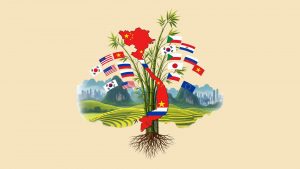Media plays a key role in information and decision making. It can reflect and shape the expectations of policymakers, investors and business groups. But the lack of enough key information can prevent countries and firms from understanding enough about other countries, firms and the market. Amid differences in culture, business interests, political views and geopolitical competition, many traditional media groups have struggled with the flow of information. Companies can therefore struggle to find the best strategy and business model. This is especially true in trade and investment between China and the West, where the lack of up-to-date information has always been an obstacle to vital communication.
The impact of language barriers
It’s always been a daunting task for the media, both East and West, to give a full picture to their respective audiences, of the kaleidoscope of reality on ‘the other side’. Differences in language and culture remain one of the biggest barriers. Google Translate, for example, still cannot reliably translate articles from Chinese languages into English. The Chinese group of languages (not just Mandarin and its regional dialects, but also Cantonese, Hakka and dozens of others) are considered the most difficult languages to learn, even for Chinese people immersed in them since childhood. Not many foreigners, especially Westerners, could master the language like locals do, as it takes many years – even decades – of learning and practice.
China is so vast and diverse, with so many different cultures and languages, that it is more akin to the European Union than to an ordinary nation-state. Oscar Wilde’s quip on the differences between England and the US might also describe the differences between East and West: they are fundamentally identical, except, of course, in terms of language.
Unification has been a constant theme of Chinese history for more than two thousand years, for political and economic reasons – from the creation of a unified state to the development of a single market. While China has long been criticised by the Western powers for not being open or transparent enough, within China itself, being open and transparent has always been a challenging demand, both at the local and central government levels. Western observers can often fail to understand the nature of the Chinese system.
Likewise, it can be very hard for Chinese observers to fully understand the West, and its democratic systems. Media organisations on both sides can easily generalise events and clog up the flow of accurate information. This is one possible reason that Chinese and Western media groups look at each other’s countries through painted veils of cultural gaps and political differences. These differences are also being exacerbated by the rapid development of technology.
The impact of new technologies
Mobile technology has developed at an explosive rate in the past three decades. Little has changed the world more than the rise of social media in the last decade, and the way that it has completely upended the media landscape. Even in China, nobody but a handful of venture capitalists could have foreseen the changes the occurred when TikTok (known in China as Douyin) was released. Social media has made it harder for traditional media groups to survive: on the one hand, audiences now don’t have to rely on a single media source to find out information about other parts of the world, where their national media may not have many correspondents on the ground. But on the other hand, too much questionable information from dubious sources has leaked onto social media, where it can attract public attention. Few in the West may realise the sheer scale of the sea-change in Chinese media, pushed by technology but remaining under the control of the Communist Party. This revolution happened because China has the largest literate population in the world – 96.8% of 1.4 billion people – and business has been vibrant since China joined the World Trade Organisation in 2001.
Artificial intelligence in China and the West
Amid the media revolution, another new era has also arrived: artificial intelligence. AI is pushing the world’s digital economy to new heights. With its rise, the global media ecosystem is also being transformed, slowly but thoroughly, from production to distribution. The speed of information crossing geographical and economic boundaries is increasing faster than ever. It is already becoming clear that AI can easily match and could probably replace the output of many journalists working today.
Many in the West have not yet been able to fully comprehend the scale of China’s AI revolution. 5G communication networks have been rolled out faster, and at a greater scale, in China than anywhere else in the world – something that has attracted the attention of no less than Elon Musk, who frequently comments on the use of AI in China. According to Xinhua, China’s main news agency, by the time Shanghai hosted an international AI conference in July this year, China’s artificial intelligence industry had reached a core market value of 500 billion renminbi (about $69 billion, or £55 billion). There are already 2.8 million 5G transmitters across the country. Chinese supercomputer capability is officially the second-greatest in the world, after the US – but there is a chance that capacity may in fact exceed the rest of the world of combined, because of off-the-books supercomputers being run under the radar to avoid American-led sanctions and chip export bans. But the rest of the world knows little of this – a situation not helped by hostile foreign reporting.
Chinese development of AI is quickly catching up to American efforts, and may soon exceed it. Here, China has a unique cultural advantage. Across East Asia, there is generally a greater tolerance for intrusive data collection, which is crucial in the development of self-training AI, than there is in the West. It is easier to build and train an AI with the massive datasets available to Chinese researchers than it is to do so in the West.
AI is already being deployed widely in China, having been tested in transportation, energy, manufacturing, medicine and even education. Farmers have trialled AI-driven crop management systems, and some schools have experimented with the development of an AI anti-bullying system that can read children’s body language. AI has also found a place in China’s media sector. As long ago as 2015, Tencent, China’s biggest tech firm, launched an AI news-writing program, “Dreamwriter”, capable of writing technical reports along provided guidelines (similar programs are just only now being rolled out in the UK). Other organisations quickly followed suit: Xinhua now uses AI to sift through data streams and collect information for its journalists, while CCTV, China’s biggest TV news channel, has experimented with using AI presenters to host some of its broadcasts. AI has been widely used, particularly in subjects where routine reports need to be churned out quickly, like financial news and sports. It has also been used on all Chinese social media platforms – where retailers have begun experimenting with using AI-generated influencers to sell their products, rather than employing humans. Amid the aforementioned social experiments in China, there has also been widespread debates in AI development circles about how to protect individual privacy rights in an era where personal data has become as valuable as gold.
Conclusions: the challenges of AI
Since the advent of AI, experts have been warning the public about the negative side of these new technologies. In the world of media, AI can easily assist the spread of fake news, which has become a massive headache for traditional media organisations. There is a further dangerous aspect to AI, that potentially threatens all of mankind: every major world power is currently researching ways to weaponise artificial intelligence. The use of AI as a weapon could follow the trends set by drones: once the preserve of governments, they are now commercially available, relatively cheap, and have transformed warfare. To use China as an example, we find that Chinese-manufactured drones, costing only a few hundred dollars off the shelf, have been widely used in global conflicts, from the Middle East to Africa to Ukraine. Just as we currently worry about drones, will we soon have to worry about AI? Will we need to establish an international organisation to regulate the use of AI, as we do with nuclear weapons?
International regulation of AI has already become fragmented, and multi-centred. It has fallen far behind the pace of technology. Amid this pacing problem, where the Western powers complains about a Chinese lack of transparency, and China in turn complains about its exclusion from discussions about regulation among the G7 and EU. As 2023 comes to a close, we find a rapidly changing global political economy, and rising tensions between East and West.
The British government, which is trying to position itself as a leader on artificial intelligence, is going to host the first global AI security summit in Bletchley Park, just outside London, in November. China’s attendance at the conference, only recently confirmed, has proved controversial: there has been significant pushback from some groups, driven by fears of Chinese spying and by political competition. But one could reasonably ask: how one could hold a global summit on AI without the world’s second AI superpower? Co-operation with China over AI regulation, aided by better-informed media coverage, is the only way the world can avoid sleepwalking into a technological cold war, and instead work together to improve the flow of information and keep international commerce running smoothly. But to do so, China and the West must also find a balance between their different values – most of all in AI and in media.
Xin Li
- This author does not have any more posts.





